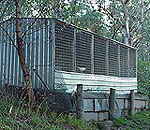Let's look at suitable
housing and what is required. The chook shed must provide:
1. Protection from the
weather
2. Protection from predators such as dogs and foxes
3. Feeding and watering facilities
4. A place to sleep
5. Somewhere to lay eggs
There are a number of different methods of housing
chooks we can look at. Firstly is the commercial type sheds, small
individual cages for laying stock or intensive deep litter sheds for broilers. Obviously,
these are hardly suitable for your back yard. Next is the free-range
method. The birds are allowed to roam at will during the day and are housed in simple
sheds at night. The main dangers with this system are the threat from predators, birds
laying eggs in hard to find places, greater chance of the birds contracting parasites like
worms, difficulty in managing the birds diet and lastly, not many people have neighbours
who will like fowls roaming the streets. Incidentally, most so-called "free
range" eggs sold in supermarkets are not actually so. Most of these eggs come from
birds run under semi-intensive conditions.
The semi-intensive or deep
litter method is, in my opinion, the best way to keep chooks. This is simply a
shed with a covering of deep litter on the floor, somewhere for the birds to roost and an
enclosed yard for them to exercise. The positioning of the shed is important, the front
should always face the north in the southern hemisphere or the south in the northern
hemisphere. This allows the winter sun to shine into the shed and if positioned just right
will shade them in summer from the hot sun. By keeping the litter deep and dry, bacterial
action within the litter itself breaks down wastes and keeps the shed clean and hygienic.
Litter usually comprises all or some of these materials: wood shavings, rice hulls, dry
leaves, soil, and perhaps some dry horse or cow manure. Straw is NOT recommended because
it does not absorb moisture and the stalks are hollow, allowing mites and other pests to
hide and breed within.
Chickens are very susceptible to illness if they are
forced to roost in drafty conditions. When designing your shed, keep this in mind and make
sure all cracks and crevices are filled. Keep the perches away from the walls to prevent
the birds sleeping next to them from chilling. Another important point to remember when
placing perches is to keep them all on a single level. Perches placed above each other
result in the birds on the lower ones being soiled and dirtied by those above.
If your area is inhabited by foxes or other vermin,
lay wire mesh along the ground under the shed. Make sure this wire protrudes at least 2
feet past the outside walls. This prevents predators from digging under the shed to attack
your valuable stock. You can pin it down using small tent pegs and cover with soil to a
shallow depth. This works much better than burying the shed walls in the ground as vermin
can still dig under walls and the danger of rust or rotting of the shed is minimised. For
best protection, a concrete floor can be laid. This also makes cleaning tasks much easier,
however a deep cover of litter must be used to prevent the birds suffering from the
effects of extreme cold in winter. Uncovered, cold concrete floors can result in arthritis
and necrosis of the toes, as well as not allowing the birds anywhere to dig and scratch.
Finally, allow enough space for each bird to be
comfortable. Chickens are VERY territorial critters, even in a large shed. Poor siting of
feeders and waterers may result in less aggressive birds missing out on these necessities.
The best solution is to allow the birds access to a run or some range outside the shed
whenever possible. |

Front view of my own chook shed made from
converted garden sheds.
This shed faces north to maximise winter sun while the many shade trees protect it
from summer heat.

Close-up of the doors, made from heavy welded
mesh. These do not require framing, yet are very strong. Canary wire can be
placed over each door to keep unwanted wild birds out.
This shed is partitioned into six individual bantam breeding cages, each 3 metres
by 1 metre.
|